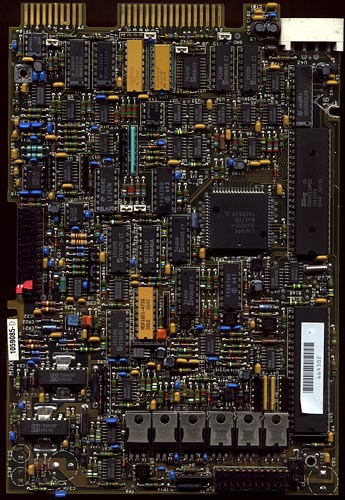Apropos my previous post about file hosting services, the perfect repository for at least some big files occurred to me.
And so...
It's a 1200dpi scan of a 5.25 inch hard drive controller board, from this scanner review from almost eight years ago. The board is of course rather older than that; it's from the days before surface mount (OK, nitpickers, before everything was surface mount), when electronics took up more room and looked much cooler.
That cheap little scanner did a quite commendable job. Not quite 1200 whole dots per inch of detail, but still a whole lot of it in this 66 megapixel (!) image. Which ought to be quite enough for anybody's desktop wallpaper.
If you've got some giant image, sound or video file that meets Wikimedia's rather loose requirements, you can upload it to the Commons and be reasonably sure that it'll be speedily available to the world for the foreseeable future.
The one caveat, of course, is that uploaded content must be covered by one or another free-use license. That rules Commons out for the 1337 w4r3z and pr0n that comprise most of the data uploaded to file-dump sites, unless you expend an unreasonable amount of effort in hiding your pirated content in something legit, and then hope they don't notice that myadorablekitten.jpg is 702Mb in size.
There are various other stock photo repositories out there; Morguefile is a good one, and you can share big images on Flickr as well if you pay for an account (otherwise the biggest dimension of your pictures is limited to 1024 pixels).
I thought I'd stick with the big guns for this image, though, because it's 12 freakin' megabytes.
(Actually, the original was even bigger. This is my second attempt - I uploaded the original untweaked scan first just to see if Wikimedia would barf on the file size, then made this prettier, slightly smaller version that benefits from some Photoshop features introduced over the last eight years. Since my Wikimedia account is younger than four days - Wikipedia and Wikimedia accounts are separate - I can't replace the old one with the new one, so I uploaded the new one as a separate file.)
Uploading your backups to FTP sites may be the really studly way to do it, but for this one niche - unreasonably large pictures of things that belong to you - Wikimedia looks pretty cool.
I hope to see many more scans of improbable objects there in the near future.

11 April 2007 at 2:44 am
My cat used to have a thing for laying on my flatbed scanner. So one day I took the top off and sure enough, she climbed right on and went to sleep. So a few quick clicks later, voila! A cat scan!
I'll get me coat.
11 April 2007 at 3:16 am
Back in the Before Time of the Web, CliffyB had a "cat scans" site featuring many examples of what you describe here. Old three-pass scanners produced particularly trippy results.
That site's been defunct for a long time, but you can still find cat scans (mixed up entertainingly with CAT scans) on Flickr, among other places.
(The budget version is to just take a picture of your cat from under a glass table.)
11 April 2007 at 9:33 am
Speaking of unusual uses for scanners, this reminded me of the Scanner Photography Project (looks like his site was costing him too much so is only found at archive.org now), where a guy created a 115 MP camera using a flat-bed scanner. It appears to be a burgeoning field, as there are a lot of hits for a google search on "scanner camera"!
30 June 2007 at 3:29 am
Wow, it's interesting to see that this old hard drive controller boasts a few 7W audio amplifier chips, probably for amplifying the signal to and from the write head.
I'm not even an electronics geek (much) and I noticed that. What is this from, an RLL drive?
http://www.datasheetcatalog.com/datasheets_pdf/T/B/A/8/TBA810P.shtml